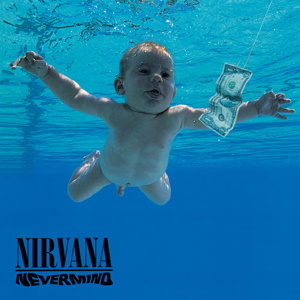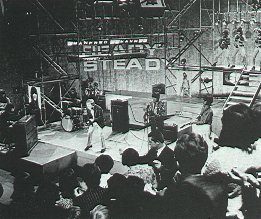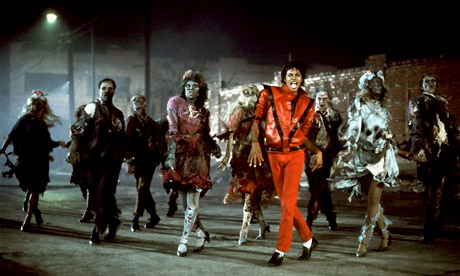By looking at some of the most famous music videos ever produced, it enables me to see what camera angles, mise-en scene, characteristics and themes worked well so that I can incorporate similar ideas into my own music video. This also allows me to explore how to effectively portray a clear, linear narrative as well as how to produce a video with not a very strong narrative (videos with live performances for example.)
Michael Jackson: Thriller (1983)
Directed by: John Landis
Thriller by Michael Jackson is one of the most successful and well known music videos of all time as it incorporated both a clear narrative, dance and song. Thriller sold over nine million copies worldwide and is the biggest and best selling album ever to be produced within the music industry. The budget for the 13 minute spectacular was $500,000 and was paid off in 1984 when Thriller won a staggering eight Grammy's. As well as telling a story, the video broke down and almost dismantled racial tensions within the USA as it was broadcast on WPLJ- a radio station in New York which was considered to be a 'white' station. Thriller then became a diverse subject as it gained criticism as there were many white racists and protestors who didnt want 'black' music on their radio station.
A-Ha: Take On Me (1985)
Directed by: Steve Barron
A-Ha was a band that had a limited amount of success but 'Take On Me' was one of the first examples to demonstrate just how MTV was a company that was powerful and influential enough to take a song that was unknown and make it into a number one single. The video was one of the first to follow a narrative therefore the overall concept of it was considered clever and even more unique for the time it was produced.
Beyoncé: Single Ladies (2008)
Directed by: Jake Nava
'Single Ladies' by Beyoncé was initially released on her third studio album 'I Am Sasha Fierce' on October 12th 2008. Along with 'If I Were a Boy', 'Single Ladies' was one of the most popular tracks from the album and peaked at number one on the US Hot Billboard Chart and was included in the top ten newly released singles charts worldwide. The music video for 'Single Ladies' was shot by Jake Nava straight after both him and Beyoncé had just finished shooting 'If I Were a Boy' in New York City. Beyoncé had previously worked with Nava on her previous music videos 'Crazy In Love' and 'Beautiful Liar' so she was not only familiar of his work, she was highly fond of it. 'Single Ladies' was shot in black and white- a continuous theme from her previous video 'If I Were a Boy' and the catchy choreography which had the whole world dancing was inspired by 'Mexican Breakfast. The video soon gained popularity and became the first major dance craze of the internet with people worldwide creating parodies and imitations of the video.
Peter Gabriel: Sledgehammer (1986)
Directed by: Stephen R.Johnson
One of the main reasons as to why Peter Gabriel's 'Sledgehammer' is considered one of the best music videos of all time is due to the amazing stop-motion animation used to create a captivating video. For the video to get it's full effect, Gabriel had to lie under a sheet of glass for 16 hours whilst filming one frame at a time. This was one of MTV's most important videos of all time as it won nine VMA's in 1987 and also became the most viewed and played video in the history of the channel.
Bjork: All Is Full of Love (1999)
Directed by: Chris Cunningham
Bjork's fifth album 'Homogenic' features the track 'All Is Full of Love'. The album version of the song is the original, non edited track, whereas the music video is a remix. Since the video was released, it gained an enourmas amount of attention as Bjork's vocals were highly praised and the track was called 'the highlight of the album'. The track reached number 23 in the United Kingdom but reached number 8 in the US. Chris Cunningham is noted for his bizarre style- most notably the use of animation in Bjork's video. 'All Is Full of Love' was considered a milestone for computer animation due to the fact that it was a complicated piece of technology at its time of release. Due to the video's futuristic look, it is on stationary exhibition at the Museum of Modern Art in New York City as well as being listed as one of the best music videos of all time by MTV and TIME Magazine.

















































